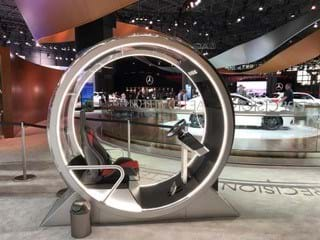
Driver’s Seat: 2017 New York Auto Show
Last week, the New York International Auto Show (NYIAS), a pinnacle of the automotive industry, swept Manhattan. Auto shows are to the auto industry what the Grammy Awards are to musicians or the Golden Globes are to starlets. From Los Angeles to Detroit and Geneva to Chicago, the world’s leading automakers take the show floors to celebrate their brands, heritage and future.
Some journalists have recently speculated that the importance of auto shows is fading due to astronomical costs and a changing media landscape. However, leading automotive manufacturers continue participating in auto shows around the world. Consumer, tech and national broadcast media also flock to show floors to cover reveals, unveils and press conferences. Major outlets like CNN, Architectural Digest and Fortune cover the hottest cars, produce “best of” lists, and film inside, outside and under the hoods of new vehicles.
We always enjoy these shows. They show us a glimpse into the best and brightest of the automotive industry and provide us the opportunity to identify takeaways for our work as communicators. Outside those “best of” lists, below is an overview of the trends we saw while onsite at this year’s show.
Electric Reigns Supreme
 Recently, electric vehicles, or “EV” anything, have been top of mind for the industry and consumers. Nearly every automaker used NYIAS to make a stake in the EV market. From BMW and Mercedes to Porsche and Genesis, each automaker had an electric car, component or display on the floor. And when companies weren’t announcing their latest EV models, they were showcasing their newest green technologies. Our takeaway: Electric technology is not only a necessity for automakers to remain competitive within the industry but also a key to engaging with consumers about “doing good” for the world.
Recently, electric vehicles, or “EV” anything, have been top of mind for the industry and consumers. Nearly every automaker used NYIAS to make a stake in the EV market. From BMW and Mercedes to Porsche and Genesis, each automaker had an electric car, component or display on the floor. And when companies weren’t announcing their latest EV models, they were showcasing their newest green technologies. Our takeaway: Electric technology is not only a necessity for automakers to remain competitive within the industry but also a key to engaging with consumers about “doing good” for the world.
Auto + Tech
Tech was pervasive at NYIAS for both luxury and non-luxury automotive brands. Chevrolet’s stand included a “TechStudio,” and Nissan developed an augmented reality station in partnership with “Star Wars: Rogue One.” Acura stood out with a full VR experience, dubbed “NSX,” that allowed consumers to encounter various driving scenarios with the company’s hybrid sports car from the show floor (pictured at right). Our takeaway: As the auto and tech worlds continue to merge and evolve, so are expectations around the way people experience a brand.
Lifestyle Brands
Brands were also busy blurring lines and transforming both their identity and their offerings. A number of traditionally “automotive” brands showed up as new, holistic “lifestyle” companies. From designer collaborations, like Maserati’s Ermengeildo Zegna apparel line, to elite concierge offerings and services, like Lincoln’s “Black Label,” luxury brands leveraged their NYIAS platforms to make a name for themselves outside the automotive realm. Our takeaway: To break through the noise and make powerful connections with consumers, brands need to prove their product provides more than just a single service and truly enhances the consumer’s life.
Celebrating the Past
Volvo’s (a WE client) day-two display, an homage to its vintage cars in celebration of the company’s 90th anniversary, truly stood out. It was not alone in its nostalgic style, however. Brands like Subaru used the show floor to not only highlight their latest and greatest iterations, but also to celebrate models of years past. This was yet another avenue for automotive brands to penetrate the hearts of customers and become a part of their lifestyle. Our takeaway: Consumers love a good throwback, but brands need to make sure there’s an authentic reason or value behind a nostalgic play.
Connect with the author, Anna Coccodrilli, on Twitter.
The latest blogs from WE
Pride is Democracy
Overcoming the Lack of Diversity in Clinical Trials
Is Corporate Purpose Still Relevant in 2024?

